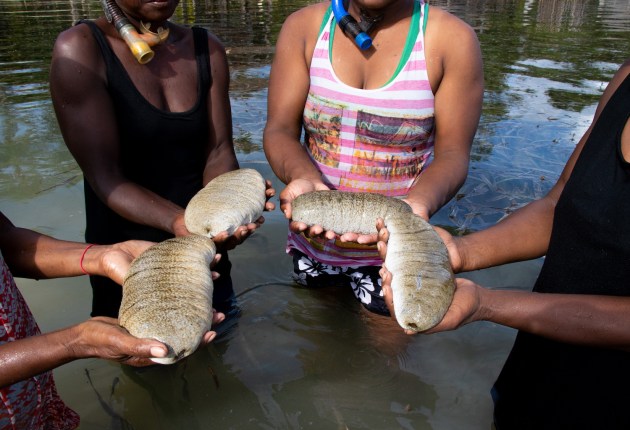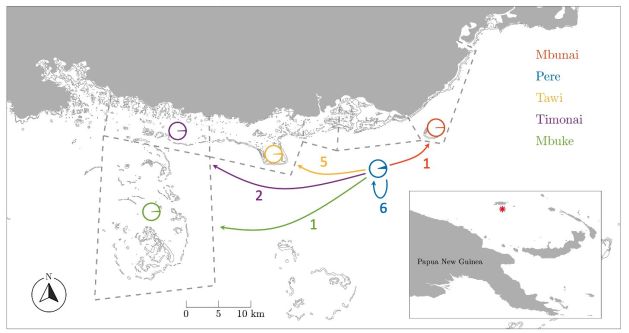New research, published in Frontiers in Marine Science, shows that most sandfish larvae do not travel far from where they were born in coastal Papua New Guinea. The results have implications for fisheries management, indicating that locally managed marine areas are an appropriate way to protect sea cucumber stocks for communities.
The Gist
Nature Conservancy (TNC) scientists and their partners used genetic parentage analyses and statistical modeling to understand sea cucumber dispersal. The researchers collected DNA samples from 765 adult and 827 juvenile sandfish (Holothuria scabra) in Manus Province, Papua New Guinea.
Genetic analysis identified 15 juveniles that were the offspring of parents sampled from Pere fishing grounds. Modeling showed that the average sandfish larvae traveled 15 kilometers from its spawning location, with 50% of larvae settling within 6.7 km of their parents and 95% of larvae settling within 59 km of their parents.

The Big Picture
Sea cucumber fisheries, when open, are extremely important for coastal Pacific communities, which often have few resources that they can easily monetize for export. Sandfish are a particularly prized species, because they are high value, easy to process, found in shallow waters, and can be harvested by women, men and children. “I always think of them as gold bars in the sea,” says Richard Hamilton, a senior conservation and science advisor at TNC. “They’re an important source of income in places where it’s pretty hard to make a dollar.”
This easy-to-harvest species is also susceptible to overfishing. TNC worked with Titan communities in Manus, Papua New Guinea, to establish a network of locally managed marine protected areas (LMMAs) on their traditional fishing grounds. The hope was that the LMMAS would protect spawning stock, therefore replenishing surrounding reefs and acting as a buffer against overfishing.
“Like many invertebrates, sea cucumbers release their gametes into the water where they’re fertilized externally,” explains Hamilton. Those juvenile sea cucumbers then float on the currents before settling on a reef to develop into adults. “But where these critters are funny is that their reproduction is triggered by pheromones. And if the densities get too low, they won’t reproduce.”
LMMAs have proven effective for other species, but until this study, scientists didn’t have any empirical measure of larval dispersal patterns for sea cucumbers. In other words, they had no way of knowing if the juvenile sea cucumbers spawned in the protected areas would actually benefit the communities that established them, or if they’d drift elsewhere in the Pacific.

The Takeaway
This study demonstrates that the Titan tribes’ LMMA network is well suited to manage sandfish populations, because the spatial extent of the network pairs well with larval dispersal patterns. Most larvae drift no more than 59 kilometers from their natal reef, meaning that the majority will stay and settle within the 65 kilometers of coastal LMMAs.
Hamilton says that LMMAs are designed to mimic cultural practices that have been in place for centuries, and work best when they focus on species that the community considers a valuable resource. “Communities have more of an incentive to manage resources that they care about, especially in the absence of strong governance at the provincial or national level,” says Hamilton.
Beyond Manus, this study demonstrates that LMMA networks at small spatial scales can have local benefits. Hamilton also cautions that their results reinforce the need to protect spawning stock, too. “It’s easy to overfish this species,” he says, “and with these relatively short larval dispersal distances, if that happens, these populations probably won’t recover.”



